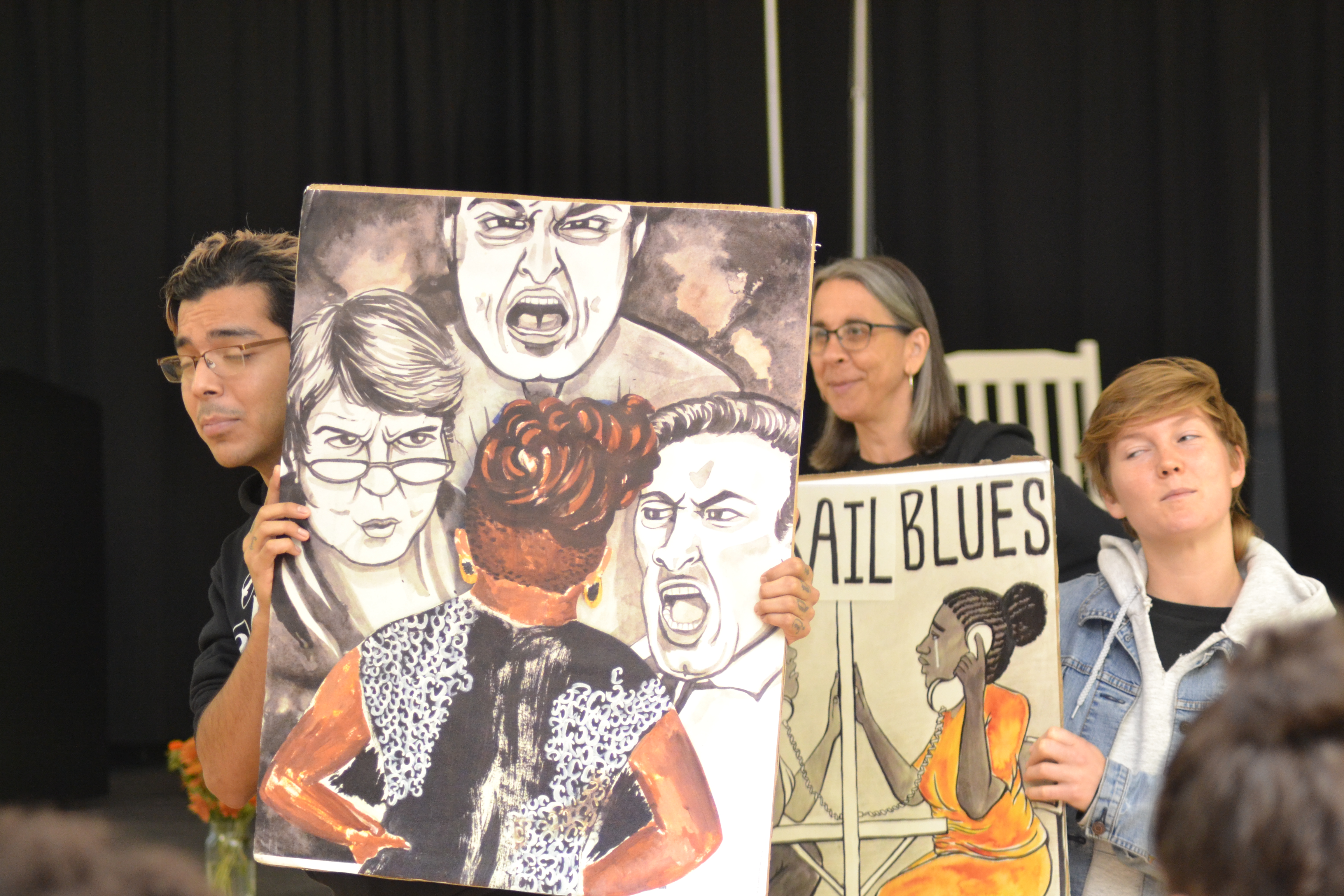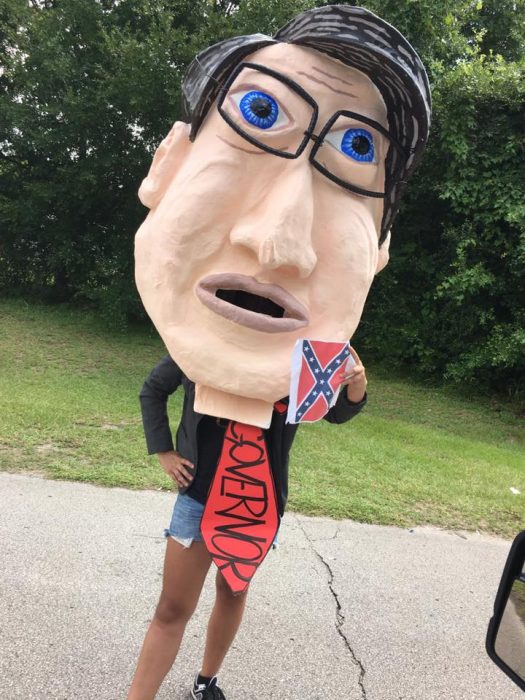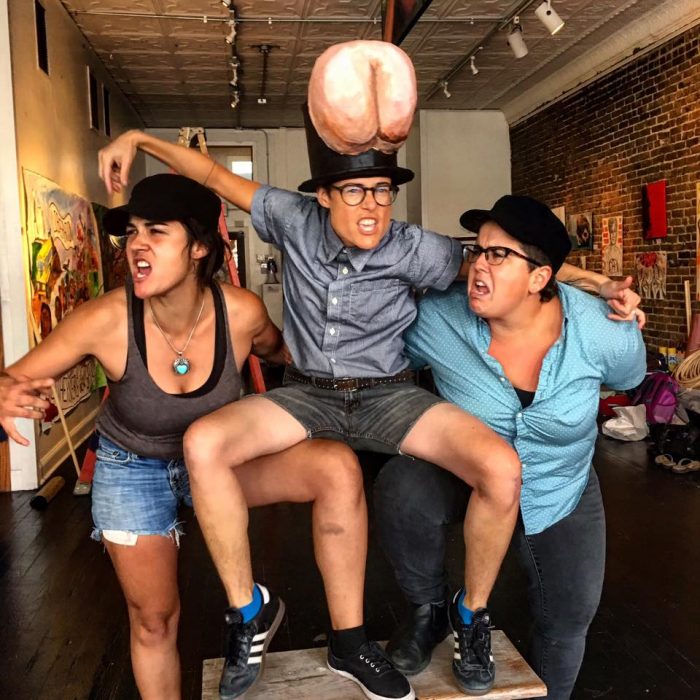Una entrevista de arte y cultura con miembros de SONG
[English Below]
¡En SONG, el trabajo de arte y cultura es fundamental para nuestro trabajo de movimiento! Queríamos compartir la memoria histórica del trabajo artístico y cultural en SONG y nuestra colaboración con AgitArte, así que entrevistamos a una miembro Forever SONG, Kate Shapiro, quien ha sido una parte esencial del trabajo cultural de SONG. También entrevistamos a nuestrx Becarix de Comunicaciones Regional, ND Johnson y a lx miembro de SONG, Teddy G, quienes actualmente están liderando el trabajo clave de teatro de guerrilla.
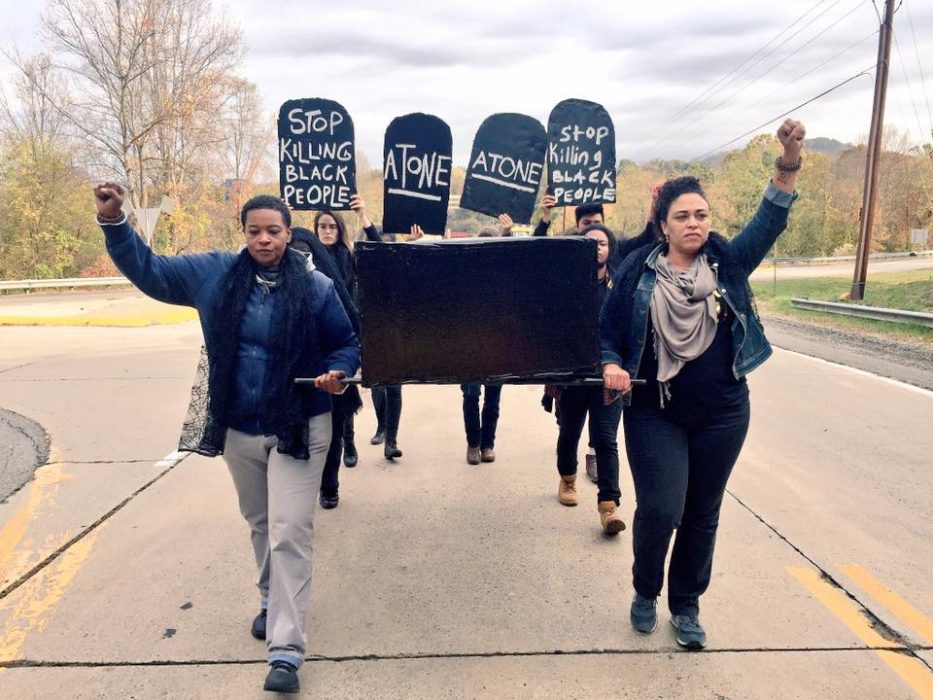
¿Puedes compartir un poco sobre la evolución de la colaboración entre SONG y AgitArte?
Kate Shapiro: Nuestra colaboración con AgitArte empezó de manera espontánea, cuando AgitArte invitó a SONG a ser parte de este libro que estaban haciendo, llamado Cuando luchamos ganamos. Luego, durante su gira para presentar el libro, vinieron y realizaron unos talleres para nosotrxs y nos mostraron todos sus diferentes teatros de calle, sus diferentes títeres y sus cantastorias. ¡ Nos dimos cuenta que nos entendíamos perfectamente!
Algo que compartieron fue el trabajo que estaban haciendo con estudiantes manifestantes súper-militantes en la Universidad de Puerto Rico, en dónde estaban creando escudos que llevaban unos hermosos esténciles, y hechos de unas barricas plásticas de 50 galones. En SONG, dijimos, “¡Lo único que queremos y necesitamos en nuestras vidas son esos malditos escudos! O sea, ¡si pudiéramos tener a 300 personas queer con los escudos, no se sabe lo que pudiéramos lograr!” ¡Abrió nuestro sentido de posibilidad y nos ofreció millones de cosas que ni siquiera hubiéramos imaginado!
En nuestro trabajo con AgitArte, empezamos con los títeres y los cantastorias, lo que fue genial. Pero estos fueron objetos que se convirtieron en objetos sagrados. ¿Cómo los podíamos movilizar? Empezamos a preguntarnos cómo podíamos construir un equipo que esté localmente arraigado pero vinculado a nivel regional, para realmente poder avanzar algunas de estas ideas como experimentos culturales. Entonces nos enfocamos más en teatro de guerrilla.
¡El teatro de guerrilla fue la evolución absoluta de determinar cómo construir una alegre banda de bromistas capaces de usar un conjunto de habilidades en una variedad de formatos y adaptarlos a condiciones diferentes!
Para comenzar, ¿por qué es importante integrar componentes de arte y cultura en el trabajo de SONG?
Teddy G: Arte y Cultura es un componente esencial de nuestro trabajo porque es el hilo que une a todas nuestras culturas. Consiste en historias, canciones, y hasta memorias que nos recuerdan quiénes somos, de dónde venimos y cómo estamos conectadxs. Creo que uno de los aspectos más asombrosos de Arte y Cultura es su naturaleza intergeneracional. Aprendemos historias de lxs antepasadxs de nuestrxs antepasadxs que moldean cómo hacemos el trabajo, y nos enseñan sobre los errores que no tenemos que cometer porque ya sabemos qué hacer de manera diferente. El Arte y Cultura es una lengua universal.
ND Johnson: El arte siempre ha sido una parte y un comentario sobre el mismo movimiento. Sin el arte, creo que la gente pierde visión e imaginación sobre todo lo que podemos construir. El movimiento necesita a lxs artistas para ayudar a colorear fuera de las líneas y pensar más allá de los límites.
¿Qué es el teatro de guerrilla, y cómo lo ha usado SONG en nuestro trabajo?
ND: Me gusta pensar en el teatro de guerrilla como una forma de teatro popular militante, que es la narrativa del pueblo, por el pueblo y para el pueblo. Es una táctica empleada para concientizar, desafiar la injusticia, y unir a la gente en la misma lucha con principios.
Como miembros de capítulo, ¿el trabajo organizativo cómo impacta el tema del espectáculo?
Teddy: Las narrativas que hemos podido construir a base de nuestra gente que está en las cárceles y sus experiencias, fueron el punto focal del mensaje de SONG. Durante nuestra función en Nashville en septiembre de 2019, nos motivó el hecho de que, en ese entonces, nuestra gente no había tenido una comida caliente en las cárceles por tres meses. Nos motivó una balacera de ICE que ocurrió aproximadamente dos semanas antes de nuestra acción. Inspirarnos sobre estas cosas de la vida real que han estado ocurriendo en nuestros vecindarios, ayuda a formar un vínculo entre el público objetivo de estos espectáculos, y las víctimas de los sistemas que queremos desmantelar.
¿De qué manera se ha usado el teatro de guerrilla como herramienta para las comunidades de clase obrera, arraigado en la educación popular? ¿Por qué es importante centrar la política de la clase obrera?
Teddy: El teatro de guerrilla centra la política de la clase obrera porque esta es nuestra gente. Si no involucramos a nuestras comunidades en la lucha, estamos en peligro de dejar fuera de la conversación a la gente que está directamente impactada por estos sistemas.
ND: Algunas veces las personas se sienten solas. Pueden estar experimentando traumas y angustias similares, como la separación de su familia por ICE o el envenenamiento de sus sistemas de agua por su gobierno. Es difícil enfrentar estas cosas a solas, pero el teatro de guerrilla es una manera de unir a tu gente en solidaridad y empujar el movimiento hacia adelante. Juntxs, tenemos más poder. De esta manera sobrevivimos.
¿Puedes describir lo que significa el teatro de guerrilla para ti, y por qué es importante traer las prácticas del teatro de guerrilla a los encuentros?
Teddy: Para mí, es una manera de decir “cualquier lugar puede ser un escenario”, y creo que eso es algo que a veces olvidamos. El trabajo organizativo no solo ocurre cuando estamos en el mismo salón juntxs, y no solo ocurre cuando estamos en las calles haciendo alcance. Tiene que ocurrir en todos los lugares en dónde nuestra gente y nuestras comunidades se encuentren. Sin mencionar, creo que es un muy buen ejemplo de cómo captar y mantener la atención de la gente.
ND, ¿Por qué era importante para ti, traer el teatro de guerrilla al pre-encuentro TGNC del Encuentro Bayard Rustin de SONG?
ND: Traje el teatro de guerrilla al pre-encuentro TGNC de Bayard Rustin porque queríamos captar a nuestra audiencia y hacer la pregunta, ¿cómo se ve la solidaridad entre la comunidad TGNC? ¿De qué maneras nos estamos ayudando entre sí? ¿Cómo nos podemos proteger? ¡ También le ofrece a mi gente otra habilidad para llevar a casa y armar escándalo!
¿Puedes compartir un ejemplo de cuando SONG utilizó el teatro de guerrilla?
Teddy: En septiembre, SONG Nashville realizó una acción contra nuestro sheriff, el director ejecutivo de Corecivic y nuestro gobernador. Hicimos una forma de teatro de guerrilla en donde hay unx líder y las otras personas se mueven por el espacio. Nuestras frases eran, “No sé hace cuánto tiempo he tenido comida caliente”, “se supone que soy inocente hasta que se demuestre mi culpabilidad”, y “ICE me disparó en el estómago.”
Al terminar las frases, caminamos hacia el frente del salón y nos pusimos en línea, algunxs de nosotrxs hacia el público y otrxs con la espalda al público, escalonadxs por seguridad. Luego cantamos las siguientes frases: “Bill Lee, la evaluación de riesgos no es pa’ mí – vamos a estar libre de miedo”, “Darren Hall, estamos aterrorizadxs, derretir a ICE es lo que buscamos – vamos a estar libre de miedo” y “CoreCivic, vete al carajo – vamos a estar libre de miedo.”
¿Nuestras comunidades cómo pueden usar el teatro de guerrilla para crear movimientos y cambios culturales?
Teddy: El teatro de guerrilla puede presentarse de mil maneras. Puede estar presente en las escuelas, autobuses, restaurantes públicos, y puede agitar a gente que normalmente no vemos a diario. Genera cambios porque estimula el pensamiento, llama la atención y requiere emoción. El teatro de guerrilla no requiere un grado u honores especiales, requiere algo que nuestras comunidades ya tienen – la voluntad de desafiar y desmantelar los sistemas que asisten en nuestra opresión.
ND: En mi opinión, el uso efectivo del teatro de guerrilla se reduce a tres elementos: El valor de la conmoción y el asombro- ¿captura la atención de la gente? ¿es lo suficientemente extraño para provocar la curiosidad? Lugar – ¿quién es tu público y en dónde está ubicado? Y por último, certeza – ¿lxs participantes están listxs para darlo todo? Todas estas cosas se combinan para crear una obra teatral efectiva que puede causar un efecto dominó en la manera que la gente ve y se relaciona a los asuntos en cuestión.
An Arts and Culture interview with SONG Members
At SONG, arts and culture work is integral to our movement work! We wanted to share historical memory of art and culture work at SONG and our collaboration with AgitArte, so we interviewed a forever SONG member, Kate Shapiro, who has been an integral part of SONG’s cultural work. We also interviewed our Regional Communications fellow, ND Johnson and SONG member, Teddy G, who are currently leading key guerilla theater work.
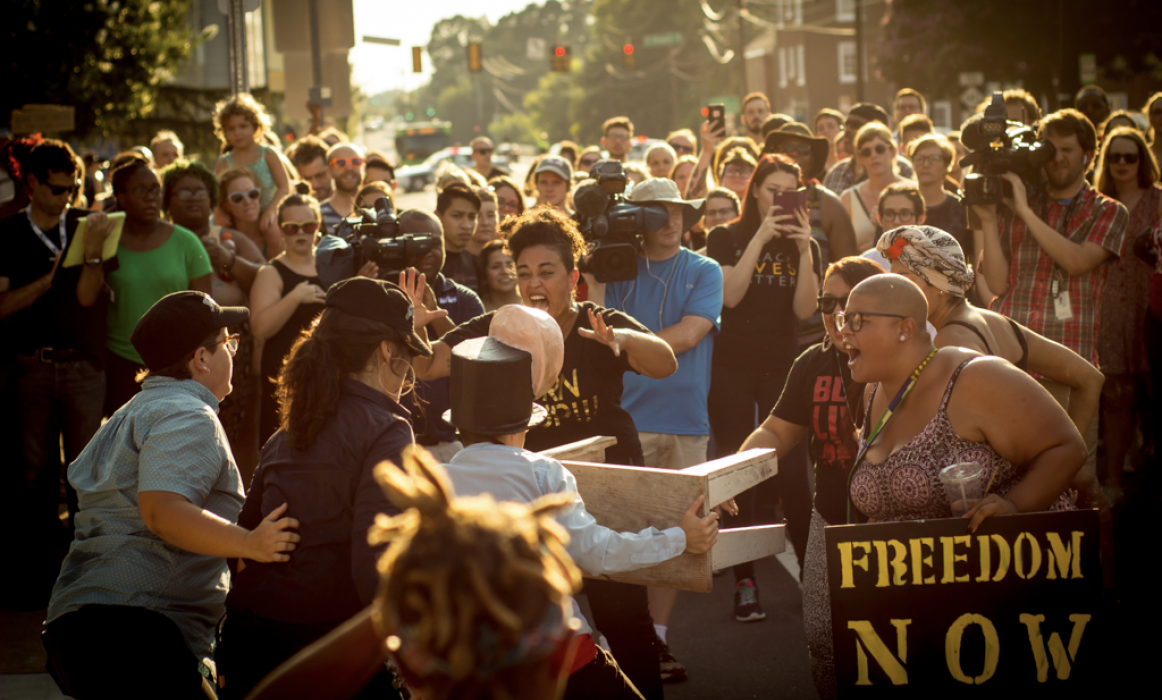
Can you share a bit about the evolution of SONG’s Collaboration with AgitArte?
Kate Shapiro: Our collaboration with AgitArte started out kind of spontaneously when AgitArte invited SONG to be part of this book they were doing called, When We Fight We Win. Then during their book tour, they came and did some workshops for us and showed us all of their different street theaters, their different puppets, and their cantastorias. We found that we had great chemistry!
One thing they shared was the work they’ve been doing with super militant student protestors at the University of Puerto Rico, where they were making shields out of 50 gallon plastic barrels which had all these beautiful stencils on them. At SONG, we were like, “All we want and need in our lives are those fucking shields! Like, if we could have 300 queer people with the shields, there was no telling what all we could do!” It opened our sense of possibility and offered millions of things we never even thought of before!
With our work with AgitArte, we started with the puppets, and the cantastorias, which was great. But these were objects that were made into sacred objects. How could we move them around? We started asking how we could build a team that’s locally rooted but regionally connected to actually be able to move some of these ideas like cultural experiments. So then we shifted more to guerrilla theater. Guerrilla theatre was the utter evolution of figuring out how we build a merry band of pranksters that can use a set of skills in a variety of formats and adapt it to different conditions!
Why is having art and culture components integrated in SONG’s work important?
Teddy G: Arts & Culture is an essential component of our work because it is the fiber that binds together all of our cultures. It consists of stories, songs, and even memories that remind us of who we are, where we come from, and how we are all connected. I think one of the most amazing aspects of Arts & Culture is that it is intergenerational. We learn stories from our ancestors’ ancestors that shape how we move work and teach us the mistakes that we don’t have to make because we already know what to do differently. Arts & Culture is a universal language.
ND Johnson: Art has always been a part and a commentary of the movement. Without it, I think people lose vision and imagination for what else we can build. The movement needs artists to help color outside the lines and think outside the box.
What is guerilla theater, and how has SONG used it in our work?
ND: I like to look at guerilla theatre as the weaponization of popular theater which is storytelling of the people, by the people, for the people. It is a tactic used to raise awareness, call out injustice, and unite people in the same principled struggle.
As chapter members, how does community organizing impact the subject of the performance?
Teddy: The narratives that we’ve been able to build from our folks that are in jails and their experiences were the focal point of the messaging for SONG. During Nashville’s performance in September 2019, we pulled from our folks not having any hot food in jails for 3 months at the time. We pulled from an ICE shooting that happened about two weeks before our action. Pulling from these real life things that have been happening in our neighborhoods helps to bridge the barrier between the targeted audience of the performance and the victims of the systems we’re trying to dismantle.
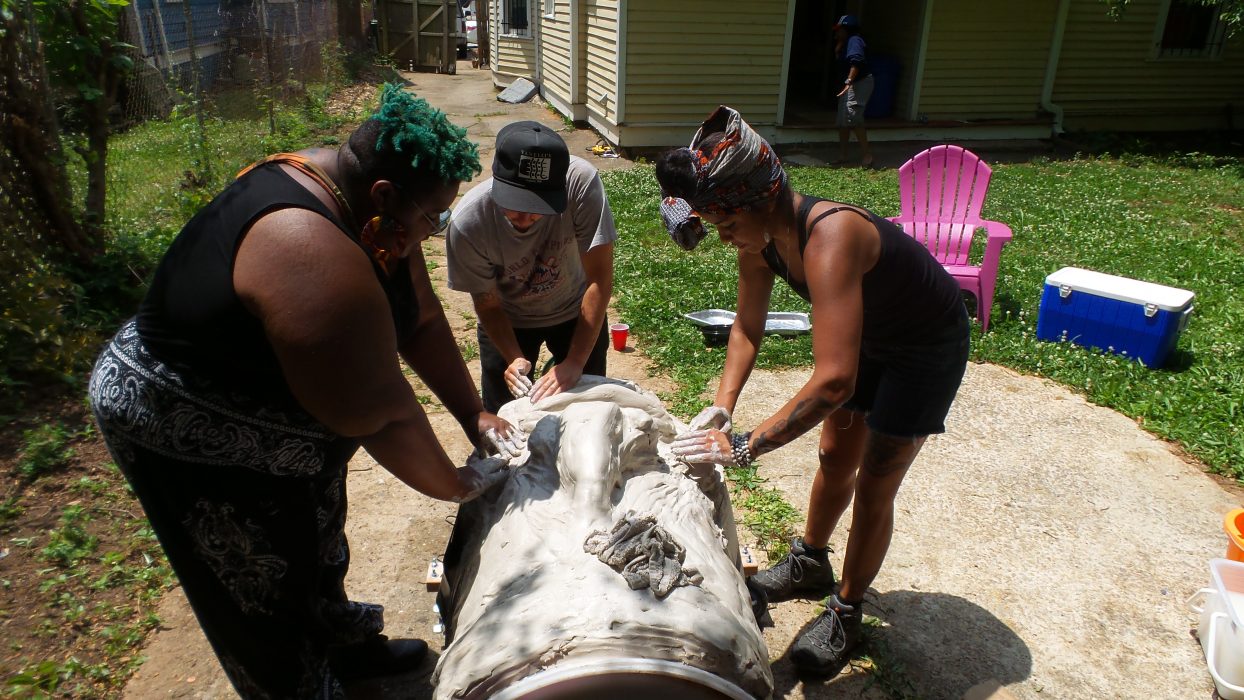
How has guerilla theatre been used as a tool of working class communities, rooted in popular education? Why is centering a working class politic important?
Teddy: Guerrilla theatre centers a working class politic because these are our folks. If we don’t pull our communities into the fight with us then we are in danger of leaving the folks that are directly impacted by these systems out of the conversation.
ND: Sometimes people feel alone. They may be experiencing similar traumas and heartbreaks like their family being split apart because of ICE or their water systems being poisoned by their government. It’s hard to confront those things alone, but guerilla theater is a way to bring your people together in solidarity and push the movement forward. We have more power together. This is how we survive.
Can you describe what guerilla theatre means to you and why is it important to bring Guerilla theater practices to convenings?
Teddy: For me, it’s a way of saying “any place can be a stage” and that’s something I think we lose sight of sometimes. Organizing doesn’t just happen when we’re in the room with each other and it doesn’t just happen when we’re on the streets doing outreach. It has to happen everywhere that our people and our communities are occupying space. Not to mention, I think it’s a damn good example of how to grab folks’ attention and keep it.
ND, why was it important for you to bring guerilla theatre to the TGNC preconvening at SONG’s Bayard Rustin Convening?
ND: We wanted to target our audience and ask the question, what does solidarity look like among the TGNC community. In what ways are we helping each other, how can we protect each other,? It also offers my people another skill to take back home and raise a little hell with!
Can you share an example of where SONG has used guerilla theatre?
Teddy: In September, SONG Nashville performed an action against our sheriff, the CEO of Corecivic, and our governor. We did a form of guerrilla theatre where there is one lead person and the other people are moving throughout the space. Our phrases were “I haven’t had hot food in I don’t know how long,” “I’m supposed to be innocent until proven guilty,” and “ICE shot me in my stomach.”
Once we finished with the phrasing we moved to the front of the room into a line formation where some of us were facing the audience and others had our backs to the audience, staggered for safety purposes. We then chanted the following phrases: “Bill Lee can’t you see risk assessments ain’t for me – we will be Free from Fear,” “Darren Hall we’re appalled, melt ICE is the call – we will be Free from Fear,” and “CoreCivic get the fuck out – we will be Free from Fear.”
How can our communities utilize guerilla theatre to create shifts and cultural changes?
Teddy: Guerrilla theater can show up in so many ways. It can show up in schools, on buses, in public restaurants and agitate folks that we may not get to see on a daily basis. It creates changes because it is thought provoking, it commands attention, and it requires emotion. Guerilla theatre doesn’t require a degree or special accolades, it requires something our communities already possess – a willingness to challenge and dismantle the systems that aid in our oppression.
ND: In my opinion, effective use of guerilla theatre comes down to three factors: Shock and awe value – does it capture people’s attention? Is it strange enough to incite curiosity?; Venue – who is your audience and where are they located?; and lastly, conviction – are the players willing to give it their all? All of these things combine to make an effective theater piece that can cause a ripple effect in the way people see and relate to the issues at hand.
